Ryan Cook and Julian Foddy from Double Negative’s VFX team talk about
wrangling the heroic beasts of the 'Hercules' legend, refining their in-house
tools, creature FX and animation.
Double Negative Builds Legendary Creatures for ‘Hercules’ |
|
Double Negative’s work on ‘Hercules’ brought opportunities to improve their in-house software, gain experience in CG creature building, effects and animation, and increase the efficiency of the way their teams work together, particularly their CG team with their animators and compositors. On set supervision and 2nd unit photography were important aspects of the project for their team.VFX supervisor Ryan CookandCG supervisor Julian Foddywere working on the Origo Studios set in Budapest throughout most of the shoot, which started in late July 2013 and continued to late November. Almost all the photography was shot at the studios, augmented with a few location shoots such as the huge Bessi battle staged out in a rural area. |
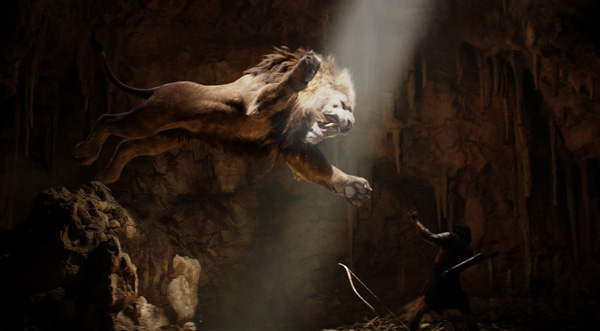 |
|
Ryan Cook said, “The movie represents a new take on traditional ideas about Hercules that also affected how we handled our effects. According to the story, various legends have been circulating about him but in this film, viewers get to see the ‘real’ Hercules, living as a genuinely heroic human being. Creatures and Legends“The creatures, our main task on the movie, are also legendary but need to feel completely real to the audience. For example, although our Nemean lion is a massive, larger than life wild cat, our CG supervisor Julian Foddy still went to the zoo with a camera to capture reference for that realistic edge. The texture painter Andy Middleton was also looking for extreme detail, down to skin pores. “This approach made Cerberus, a totally unreal three-headed dog, a challenge as well. However, having the tamer perform with three stunt actors in green suits on his leash not only improved his performance, but gave us something more realistic to animate the CG creature against and helped design the camera framing. Developing these creatures resulted in some interesting approaches.” |
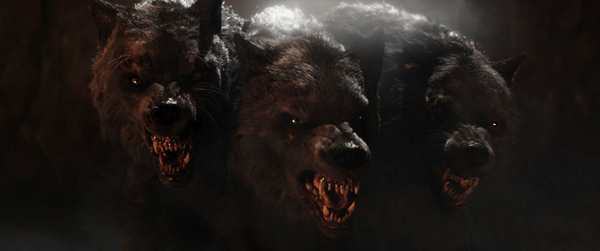 |
|
Photo Reference“When I took a trip out to Whipsnade Zoo outside London, I spent a day in the lion hide with a telephoto lens shooting full frame images of the lion’s paws and nose at a resolution high enough to use as textures. I photographed wolves as well, even though the ones in the movie are very stylized, darker and more mottled than a natural wolf’s looks. For them, the zoo shots were only for topology. The wild Erymanthean boar was a challenge because, oddly, it was hard not to make him look ‘cute’, especially when still in grey scale. It fell to the texture and creature effects artists to add the evil, demonic looks – the bloodshot eyes, drool and blood around the mouth. “We had some excellent creature concept work fromFramestoreto base our work on as well. What was extremely helpful was having 3D ZBrush sculpts of some of the approved designs that were already topologised for us and saved us a lot of the steps involved in iterating and getting approvals.” |
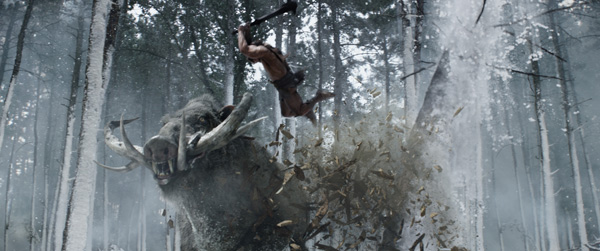 |
Fur and MusclesFor the creatures’ musculature, they used a coordinated pair of muscle meshes – one for the muscles themselves and their motion, with another mesh on top used as a render mesh that slides across the muscles. The combination is a realistic looking fatty layer sliding over muscle that can accommodate muscle and skin dynamics for character and set interactions. ‘Hercules’ was one of the first production applications of Double Negative’s proprietary fur softwareFurballto produce a fully furred creature. Furball’s code was first written several years ago as a tool called Tufty, during the production of ‘John Carter of Mars’ and has now become very intuitve, working similarly to Shave & a Haircut or Yeti. “It runs within our pipelineand is GPU-based so that the groom and lighting artists get quick updates on their fur simulations and interactions, showing the full set of hairs, not just the guide hairs. It makes it quite easy to predict the looks in the final render. ‘Hercules’ has given us a chance for a lot more R&D,” said Ryan. Clumping of snow and fur on the wild boar in the forest was one challenge. However the lion’s longer fur represented an opportunity to work on long fur dynamics especially when the lion interacted with the characters and set, tumbling onto the ground. This hair was inefficient and slow to render at first, but they eventually worked through that problem as well. |
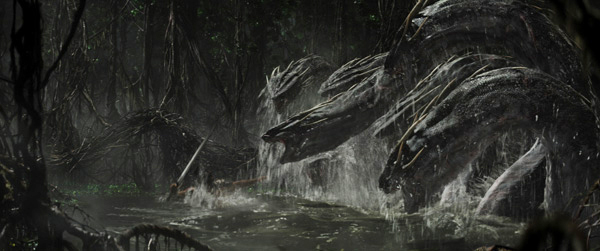 |
|
Julian said, “At first, we tried to provide predetermined cuts, but these were based on previs that in the end didn’t match the performances very closely, especially for the striking angle of the sword. So we built a procedural system into each rig that the animators could use to select their own cut point on the fly and move about to define the cutting angle. Then, they could focus on animating the fall into the water.” Worlds CollideMainly due to Hercules’ many altercations with the CG beasts, interactions and interactivity between live action and digital assets was an on-going task. “Sometimes the compositors can create them in post by introducing shadowing into the plate, but on this project they mostly had to be handled individually,” said Julian. “In one case when the three-headed CG dog Cerberus treads on a pile of dead bodies, the CG team decided to render the bodies in sections to let the compositor choose where he wanted to retain what was in the plate and where he wanted to insert CG bodies to make the dog’s footfalls more realistic. To show his preferences, he supplied a colour-coded version of the plate back to the CG team, which they used to place their work into the appropriate render layers, ready for compositing.” |
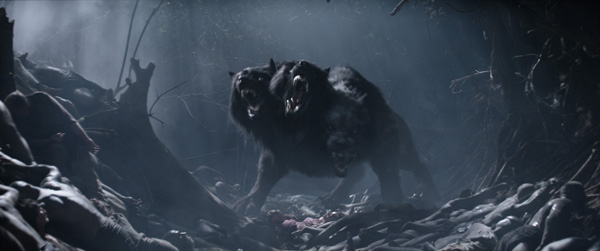 |
|
SFX Support“These interactive details are often lacking from mixed CG-live action sequences,” said Julian. “When the animators get the clean plates, it makes it harder to animate the CG creatures convincingly. Fortunately the special effects department’s attention to those performances made ‘Hercules’ a relatively smooth running production. All of the creature animation on the wolf fight and most other sequences was previs’ed and rehearsed well in advance of the shoot. Both the overallVFX supervisor Jon Brunoand the director Brett Ratner followed the signed off shot design, composition and animation quite closely – that also makes our work a more linear process.” The wolves were based on creature designs initially sculpted byRob Bliss,creature sculptor and concept artist. Then thespecial effects supervisor Neil Corboulddivided up these sculpts and had parts of them 3D printed, in particular their teeth. As the stunt actor wrestles with the lion, he could hold onto the teeth. |
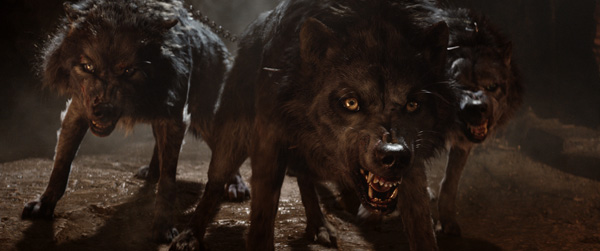 |
|
Ryan feels that a film like ‘Hercules’ especially benefits from close collaboration between the special effects and visual effects teams. “Neil’s team were very good for us to work with. When the wild boar bashes his head through a tree, the SFX team actually set up an exploding tree, precisely designed and detonated. The production wanted to see this happening in extreme slow motion but unfortunately the explosion was just too fast, regardless of the crew’s high speed camera. In the end, this effect had to be completed in CG, but having that video reference was invaluable.” Chain of DisplacementsMost of the creature sequences were shot on fairly substantial built sets. For example the lion’s cave was entirely practical and the wild boar attack was shot in a real forest dressed with practical snow, which only had to be extended with matte paintings in the far backgrounds. However, the swamp, home to the Hydra, only had a 20m by 10m tank on set with a few mangrove trees, which became a mainly CG environment surrounded by matte paintings. “The water had to be CG here as well to create effective interactions with the branches,” Julian said. “We had a chain of displacements to create - from the CG creature, to CG branches, to CG water. Our trees were created withSpeedTree. “The biggest practical set was of Cotys’ citadel, as several scenes take place there. I also did the supervision on this set. It was built in the Origo Studios backlot and measured about 100m long, 70m wide and 2 to 3m high. Standing in the courtyard, you would see the front gate of the refugee camp, front of the palace and the temple steps, all of which were real. The statue of Hera, the top of the castle and the backgrounds were CG assets.” |
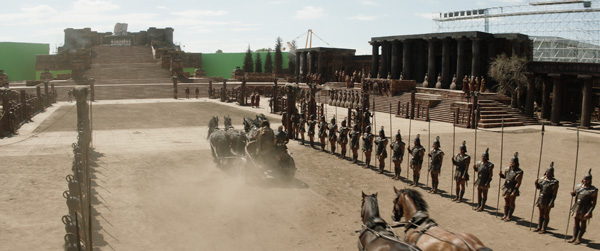 |
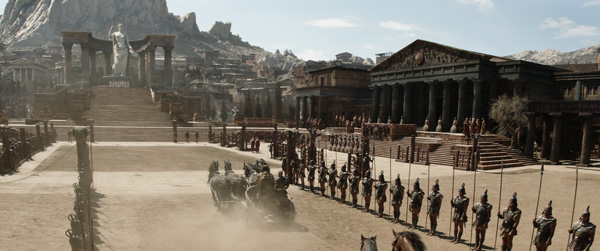 |
|
City KitUnlike most aspects of the movie, the design of the required extensions had not been locked down in preproduction and was in flux during the shoot. To handle this, the chose a procedural approach to the layout and built up a kit of parts – columns, porticos and statues – with a generic texture. This way, whenever the client wanted to adjust the layout, it did not involve a massive revision. “The system was quite successful and we could continue with the same approach up until the finalising stage, when we added the final textures and projected matte paintings into the extensions. What did slow us down was a last minute texturing change on one portion of the city from the original red sandstone to white marble. This wasn’t something our procedural kit could help us with of course – each of the component parts had to be altered.” Throughout the city, numerous effects were added in compositing to create the desired overall look and feeling. For example, dust, smoke and atmospherics from the crowds and horses were an essential part of the environment, rising up over the streets and vegetation. The compositors, led by2D supervisor Robin Beard, also added small fires and incidental details as signs of life. |
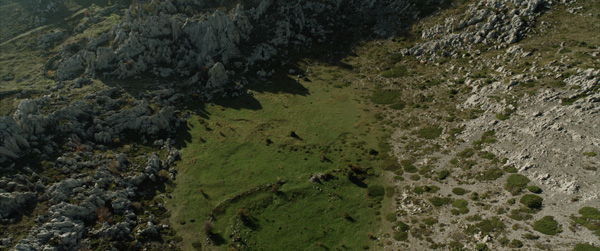 |
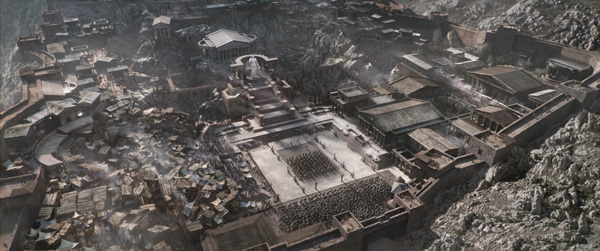 |
|
“Also, compositing the full CG version of the citadel into these plates often needed matte paintings and clean-up to properly embed and ground the city. We combined 2.5D with cyclorama approaches for the background, to accommodate tilting shots. The larger mountain ranges in the distance were given different levels of contrast and added as composited layers to allow some parallax, with fall-off adjusted for varying distances. Sometimes we used forced fall-off to suggest hazing during the battle scenes.” Gathering Cotys’ ArmyDouble Negative andPrime Focusshared the build of Cotys’ army in certain parts of the movie, with the associated crowd work - and changed their uniforms as well. The production had as many as 500 extras on set for these shots, and the largest population in the final shots was only about 1,000, although Double Negative’s team were prepared to supply up to 5,000. Therefore they weren’t relying on CG soldiers but using them for enhancement value, which made the render easier to handle than expected. |
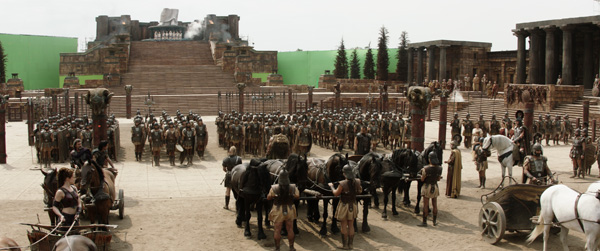 |
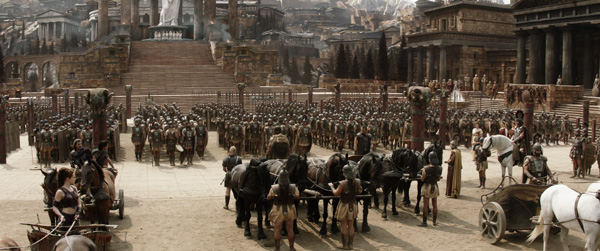 |
|
Handling ChainsThe movie involved some unusual shots that required manipulating CG assets in very specific ways. For example, the use of 3D CG chains could be quite dynamic and bring them close to camera. “When they are a fair distance from camera, you can usually handle CG chains as a ribbon or cloth simulation that you can attach a chain to. But in the wolf sequence, we designed and built a set-up for the links that worked for the closer shots," Julian said. “After you specify the length of the chain at the start of the shot, it would calculate the number of links needed to perform in your dynamic simulation. We could set parameters for rustiness and other traits defining the behaviour, resulting in smooth arcs, twists or kinks. It also helped us cope, for example, when the wolves strain at the handler’s leash. Using their true length in the concept art and composition, the chains would have gone slack, but using this set-up automatically adjusted them for tautness.” |
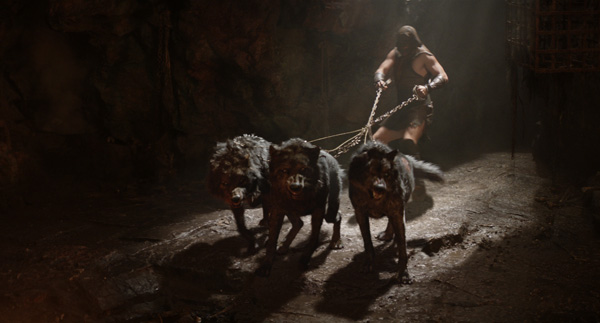 |
|
The shot of Hercules’ arm catching the spear started with the intention of using a plate of the actor performing the motion and then holding a burning spear, which they had planned to paint out and replace. However, during preparation they had built a CG arm to use at the lighting stage, which looked so much more convincing in terms of musculature, sweat and fire reflections that they simply replaced the arm as well. Body Double“Hercules had to be replaced partly or entirely several times in this film,” Julian said. “In order to capture all of the actor’s details to do this accurately, we used Double Negative’s proprietaryPhotoboothsystem, based on a lighting booth with a camera array and polarised lighting that we use to capture a long series of images. The artists then use these images to generate a model with image-based modelling software. Because both polarised and non-polarised versions of the images are recorded, the images can also be used for texturing. |
 |
|
For example, in shots when we see Hercules in the dungeon break free from his chains and leap across to kill the executioner, the actor and his stunt double both performed on a wire rig, wearing a harness that nearly obscures the whole torso. Likewise, in the top-down shots when he has just broken free and swings his arms, the live live-action swings were not ideal. In this case, the arms were replaced and animated. “A complex, assisted manoeuvre like this might need various body parts replaced at any point, and having the Photobooth scans let us do this. In the wolf fight we tested how to handle the interactions with stunt actors in green acting as the wolves to figure out just how much of the real arm or leg we could leave in the shot and still achieve convincing bites and skin damage. We ended up making bespoke CG arm or leg patches, per shot.” www.dneg.com |


















